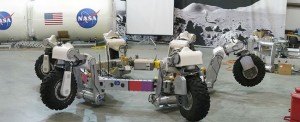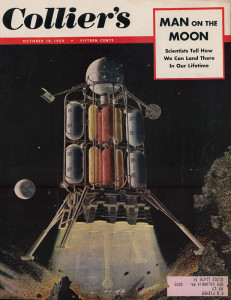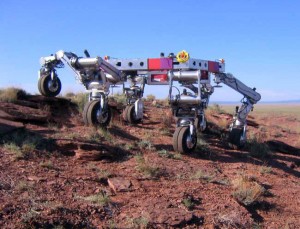 READ Part Two of our special Pasadena Weekly investigation “WE, ROBOT – JPL, home of America’s greatest robotic explorations of the heavens, isn’t sold on deep-sixing the manned space program.”
READ Part Two of our special Pasadena Weekly investigation “WE, ROBOT – JPL, home of America’s greatest robotic explorations of the heavens, isn’t sold on deep-sixing the manned space program.”
READ the full transcript of our Pasadena Weekly interview with Jet Propulsion Laboratory’s Mike Sander.
READ Part One of our special Pasadena Weekly investigation Space Monkey Business – Critics say NASA is taking a giant leap backwards by irradiating monkeys in space-travel tests.”
WE ROBOT
JPL, home of America’s greatest robotic explorations of the heavens, isn’t sold on deep-sixing the manned space program
By Michael Collins
Pasadena Weekly – March 4, 2010
The current race back to the moon and on to Mars, and the subsequent debate over manned versus robotic space flight, began with former President Bush’s “Vision for Space Exploration” speech on Jan. 14, 2004. Coming less than a year after the Space Shuttle Columbia tragedy that claimed seven lives in the skies over Texas, the president announced a bold but expensive plan to return humans to space.
The program came to be known as Constellation. Part of it encompasses injecting 18 squirrel monkeys with enough radiation to simulate an astronaut’s exposure during a Mars mission, as reported in the Weekly (see “Space Monkey Business,” Feb. 25).
“We will focus our future research aboard this station on the long-term effects of space travel on human biology,” Bush said. “The environment of space is hostile to human beings. Radiation and weightlessness pose dangers to human health. And we have much to learn about their long-term effects before human crews can venture through the vast voids of space for months at a time.”
Yet, while Bush spoke, NASA’s Mars Exploration Rover Mission’s ongoing robotic space operation, involving the rovers Spirit and Opportunity, was successfully humming along. Since the rovers have continued to work beyond their primary functions, their missions have been extended five times.
The cost of robotic, unmanned missions is estimated to be from 10 to 100 times cheaper than manned ones. The fierce debate over human space flight is sure to dominate President Obama’s proposed 2011 budget for the agency, which has axed Constellation.
The future of America’s space program will hinge on whether Obama can convince Congress to embrace robotic missions over risky and expensive human space flight. Bush posited six years ago, however, that keeping humans alive in outer space was cheaper than getting them there, which was based on some rather dubious assumptions.
“Establishing an extended human presence on the moon could vastly reduce the cost of further space exploration, making possible ever more ambitious missions. Lifting heavy spacecraft and fuel out of the Earth’s gravity is expensive. Spacecraft assembled and provisioned on the moon could escape its far-lower gravity using far less energy and thus far less cost.”
A change in tone
Bush’s vision for space exploration actually came from the leader of a group of 120 German scientists captured at the end of World War II, Waffen SS-Sturmbannführer Wernher von Braun.
Von Braun’s feared V-2 rocket rained death and destruction upon English and Belgian civilians during the 1940 London Blitz and the 1944 bombardment of Antwerp. The weapons were built by concentration camp slaves, 20,000 of whom died working on them from starvation, poisoning and execution.
But apparently one country’s Nazi is another nation’s hero.
“Wernher von Braun is, without a doubt, the greatest rocket scientist in history,” according to NASA’s Web site biography. “His crowning achievement, as head of NASA’s Marshall Space Flight Center, was to lead the development of the Saturn V booster rocket that helped land the first men on the Moon in July 1969.”
Constellation’s concept was envisioned by von Braun in a series of articles that ran in eight issues of Collier’s magazine starting in March 1952. They laid out von Braun’s idea of using a fully reusable multi-stage rocket, the conceptual precursor to the Space Shuttle, to construct a huge space station.
The floating lab would make civilian and military observations of Earth, conduct experiments in zero gravity and build spaceships for travel to the moon and beyond. The last installment of the magazine articles had humans traveling to Mars. The story’s illustrations were gorgeous and bold.
Keeping astronauts alive in space, however heroic, is exponentially more expensive than using robotic spacecraft and rovers. Critics of manned interplanetary exploration highlight the rovers Opportunity and Spirit, which have outlived their original missions by years and have provided NASA far more valuable data than ever imagined.
Even if Americans landed again on the moon, or even Mars, they would need robotics and computer technology to accomplish every task including the primary one: keeping the astronauts alive. Robots don’t run out of air, freeze to death, get burned alive or have their brains scrambled by radiation so intense NASA still can’t protect against it.
Robots just cease functioning. Or at least they’re supposed to. In January, NASA announced that the still-roving Spirit could rove no more and was repositioning itself to catch the sun’s faint rays to power out of hibernation once Mars’ fierce winter is over in about six months.
 Before getting stuck in sand, Spirit had already outlived its original three-month mission, lasting six years, traveling 4.8 miles on the Martian surface and successfully surviving thousands of daily temperature swings of as much as 150 degrees Fahrenheit.
Before getting stuck in sand, Spirit had already outlived its original three-month mission, lasting six years, traveling 4.8 miles on the Martian surface and successfully surviving thousands of daily temperature swings of as much as 150 degrees Fahrenheit.
Similarly, the Phoenix Mars Lander went silent after five months searching for environments suitable for microbial life in the Red Planet’s arctic zone. The Phoenix was a joint JPL and University of Arizona project constructed by Lockheed Martin in Denver.
But don’t count out joint manned space missions that rely heavily on robotics, said Mike Sander, manager of Jet Propulsion Laboratory’s Exploration Systems and Technology Office, created in 2004 shortly after Bush announced the Constellation initiative.
“It’s been crystal clear, I think, in speeches and in writing that there is no backing away from human space flight, but I think there’s a change in tone, an emphasis on innovation and technology that’s part of this budget story,” Sander told the Weekly. “I think that in one real way, JPL has always been about pushing back the frontiers and doing things that are more technically assertive and this, in the long run, I think will work well for the agency and JPL’s part of the agency.”













Supe-fantastic, Michael. Your article has left me speechless…well, almost. I can absolutely visualize the movie right now. You have left Avatar in the dust!
Why can’t we rent that robot to dig up the SSFL and ship all of the contamination to the moon?